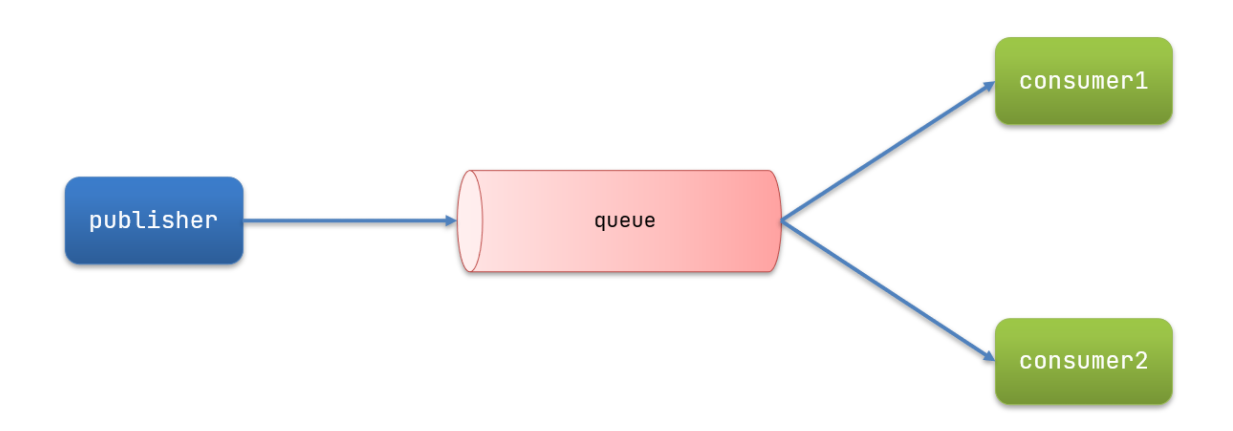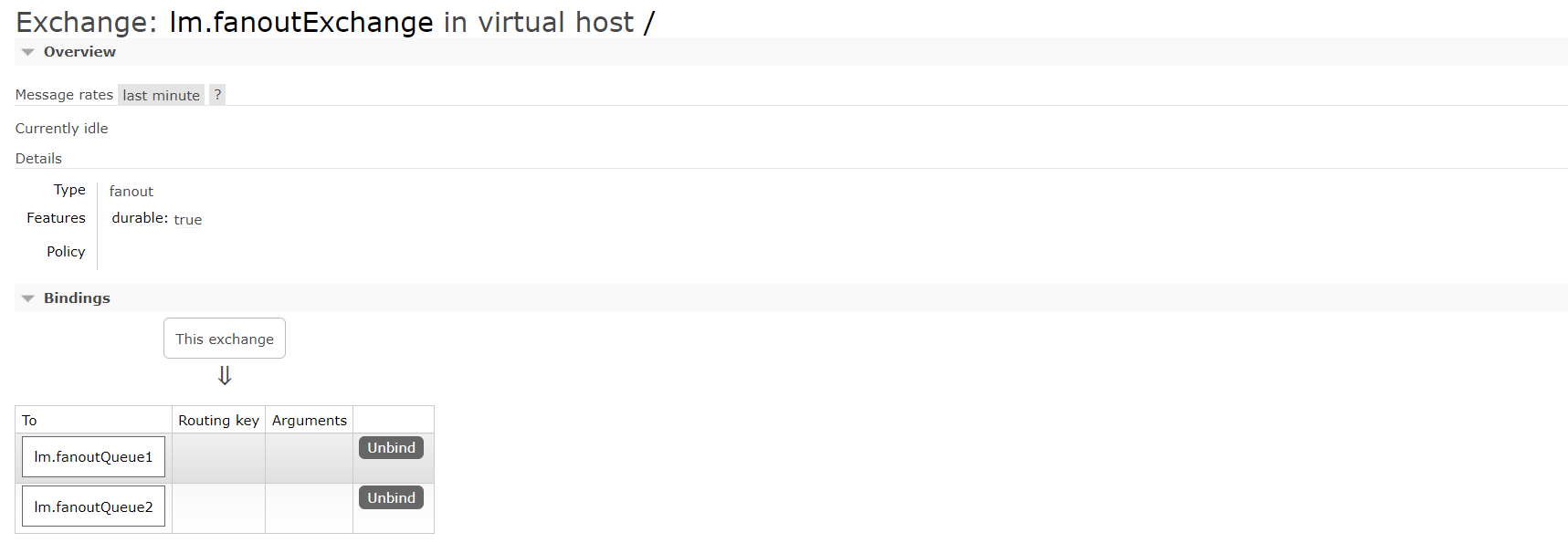SpringCloud-AMQP
SpringAMQP是基于RabbitMQ封装的一套模板,并且还利用SpringBoot对其实现了自动装配,使用起来非常方便。
SpringAmqp官方地址:https://spring.io/projects/spring-amqp

SpringAMQP提供了三个功能:
- 自动声明队列、交换机及其绑定关系
- 基于注解的监听器模式,异步接收消息
- 封装了RabbitTemplate工具,用于发送消息
父工程pom.xml
<!--AMQP依赖,包含RabbitMQ-->
<dependency>
<groupId>org.springframework.boot</groupId>
<artifactId>spring-boot-starter-amqp</artifactId>
</dependency>
application.yml
spring:
rabbitmq:
host: 192.168.88.130
port: 5672
username: lmcool
password: 1234
virtual-host: /
Appdata:
rabbitMQ-name: demo-mq
Basic Queue 简单队列模型
publisher.sendMessage2demomq
利用RabbitTemplate实现消息发送
package com.lmcode.mq.spring;
import org.junit.Test;
import org.junit.runner.RunWith;
import org.springframework.amqp.rabbit.core.RabbitTemplate;
import org.springframework.beans.factory.annotation.Autowired;
import org.springframework.beans.factory.annotation.Value;
import org.springframework.boot.test.context.SpringBootTest;
import org.springframework.test.context.junit4.SpringRunner;
@SpringBootTest
@RunWith(SpringRunner.class)
public class SpringAMQPTest {
@Autowired
private RabbitTemplate rabbitTemplate;
@Value("${Appdata.rabbitMQ-name}")
private String mqname;
@Test
public void sendMessage2demomq(){
String message = "hello springamqp";
rabbitTemplate.convertAndSend(mqname,message);
}
}
consumer.listenSimpleQueueMessage
消费者监听消息
package com.lmcode.mq.listener;
import org.springframework.amqp.rabbit.annotation.RabbitListener;
import org.springframework.stereotype.Component;
@Component
public class SpringRabbitListener {
@RabbitListener(queues = "demo-mq")
public void listenSimpleQueueMessage(String msg) throws InterruptedException {
System.out.println("成功接收消息---【" + msg + "】");
}
}
Work Queue 工作队列模型
消息处理比较耗时的时候,可能生产消息的速度会远远大于消息的消费速度。长此以往,消息就会堆积越来越多,无法及时处理。
Work queues,也被称为(Task queues),任务模型。简单来说就是让多个消费者绑定到一个队列,共同消费队列中的消息。

- 多个消费者绑定到一个队列,同一条消息只会被一个消费者处理
- 通过设置prefetch来控制消费者预取的消息数量
consumer.application.yml
控制预取消息的上限,根据消费者的能力处理消息,不是平均分配
spring:
rabbitmq:
listener:
simple:
prefetch: 1 # 每次只能获取一条消息,处理完成才能获取下一个消息
publisher.sendMessage2demomqWorkQueue
向队列中不停发送消息,模拟消息堆积。
@Test
public void sendMessage2demomqWorkQueue() throws InterruptedException {
String message = "hello, message_";
for (int i = 0; i < 50; i++) {
rabbitTemplate.convertAndSend(mqname, message + i);
Thread.sleep(20);
}
}
consumer.SpringRabbitListener
线程阻塞,模拟任务耗时
@RabbitListener(queues = "demo-mq")
public void listenWorkQueueMessage1(String msg) throws InterruptedException {
System.out.println("成功接收消息---【" + msg + "】---消费者1---WorkQueue" + LocalTime.now());
Thread.sleep(20);
}
@RabbitListener(queues = "demo-mq")
public void listenWorkQueueMessage2(String msg) throws InterruptedException {
System.err.println("成功接收消息---【" + msg + "】---消费者2---WorkQueue" + LocalTime.now());
Thread.sleep(200);
}
发布、订阅模型

交换机Exchange:一方面接收生产者发送的消息。另一方面知道如何处理消息,例如递交给某个特别队列、递交给所有队列、或是将消息丢弃。到底如何操作,取决于Exchange的类型。Exchange有以下3种类型:
- Fanout:广播,将消息交给所有绑定到交换机的队列
- Direct:定向,把消息交给符合指定routing key的队列
- Topic:通配符,把消息交给符合routing pattern【路由模式】的队列
交换机只负责转发消息,不具备存储消息的能力,因此如果没有任何队列与Exchange绑定,或者没有符合路由规则的队列,那么消息会丢失!
发布、订阅模型-Fanout【扇出、广播】
可以有多个队列,每个队列都要绑定到Exchange(交换机),生产者发送的消息,只能发送到交换机,交换机来决定要发给哪个队列,生产者无法决定,交换机把消息发送给绑定过的所有队列,订阅队列的消费者都能拿到消息
交换机接收publisher发送的消息,将消息按照规则路由到与之绑定的队列;不能缓存消息,路由失败,消息丢失

Spring提供了一个接口Exchange,来表示所有不同类型的交换机:

consumer.config
声明队列和交换机并绑定
package com.lmcode.mq.config;
import org.springframework.amqp.core.Binding;
import org.springframework.amqp.core.BindingBuilder;
import org.springframework.amqp.core.FanoutExchange;
import org.springframework.amqp.core.Queue;
import org.springframework.context.annotation.Bean;
import org.springframework.context.annotation.Configuration;
@Configuration
public class FanoutConfig {
// 定义交换机,队列,绑定队列到交换机
@Bean
public FanoutExchange fanoutExchange(){
return new FanoutExchange("lm.fanoutExchange");
}
@Bean
public Queue fanoutQueue1(){
return new Queue("lm.fanoutQueue1");
}
@Bean
public Queue fanoutQueue2(){
return new Queue("lm.fanoutQueue2");
}
@Bean
public Binding fanoutBinding1(Queue fanoutQueue1,FanoutExchange fanoutExchange){
return BindingBuilder.bind(fanoutQueue1).to(fanoutExchange);
}
@Bean
public Binding fanoutBinding2(Queue fanoutQueue2,FanoutExchange fanoutExchange){
return BindingBuilder.bind(fanoutQueue2).to(fanoutExchange);
}
}



publisher.sendMessage2demomqFanoutQueue
消息发送给交换机,参数:交换机名,路由规则,消息
@Test
public void sendMessage2demomqFanoutQueue(){
String exchangeName = "lm.fanoutExchange";
String message = "hello, message";
rabbitTemplate.convertAndSend(exchangeName,"",message);
}
consumer.SpringRabbitListener
@RabbitListener(queues = "lm.fanoutQueue1")
public void listenFanoutQueueMessage1(String msg) throws InterruptedException {
System.out.println("成功接收消息---【" + msg + "】---消费者1---FanoutQueue" + LocalTime.now());
}
@RabbitListener(queues = "lm.fanoutQueue2")
public void listenFanoutQueueMessage2(String msg) throws InterruptedException {
System.err.println("成功接收消息---【" + msg + "】---消费者2---FanoutQueue" + LocalTime.now());
}
发布、订阅模型-Direct【定向】【基于注解声明队列和交换机】
在Fanout模式中,一条消息,会被所有订阅的队列都消费。但是,在某些场景下,我们希望不同的消息被不同的队列消费。这时就要用到Direct类型的Exchange。

Direct Exchange 会将接收到的消息根据规则路由到指定的Queue,因此称为路由模式(routes)。
Direct可以指定多个key,如果多个队列具有相同的RoutingKey,则与Fanout功能类似,但是性能会不好
- 交换机都与队列绑定时指定一个RoutingKey
- 发布者向交换机发送消息时,指定消息的RoutingKey
- 交换机将消息路由到RoutingKey与消息RoutingKey一致的队列
基于@RabbitListener注解声明队列和交换机:@QueueBinding、@Exchange、@Queue
publisher.sendMessage2demomqDirectQueue
@Test
public void sendMessage2demomqDirectQueue(){
String exchangeName = "lm.directExchange";
String message1 = "hello, key1";
String message2 = "hello, key2";
String message3 = "hello, key3";
rabbitTemplate.convertAndSend(exchangeName,"key1",message1);
rabbitTemplate.convertAndSend(exchangeName,"key2",message2);
rabbitTemplate.convertAndSend(exchangeName,"key3",message3);
}
consumer.SpringRabbitListener
@RabbitListener(bindings = @QueueBinding(
value = @Queue(name = "lm.directQueue1"),
exchange = @Exchange(name = "lm.directExchange", type = ExchangeTypes.DIRECT),
key = {"key1", "key2"}
))
public void listenDirectQueue1(String msg){
System.out.println("成功接收消息---【" + msg + "】---消费者1---directQueue1" + LocalTime.now());
}
@RabbitListener(bindings = @QueueBinding(
value = @Queue(name = "lm.directQueue2"),
exchange = @Exchange(name = "lm.directExchange", type = ExchangeTypes.DIRECT),
key = {"key1", "key3"}
))
public void listenDirectQueue2(String msg){
System.err.println("成功接收消息---【" + msg + "】---消费者2---directQueue2" + LocalTime.now());
}
发布、订阅模型-Topic【通配符】
Topic交换机接收的消息RoutingKey必须是多个单词,以 . 分割;Topic交换机与队列绑定时的bindingKey可以指定通配符
Topic的交换机与Direct的相比,都是可以根据RoutingKey把消息路由到不同的队列。只不过Topic的交换机可以让队列在绑定Routing key的时候使用通配符
#:代表0个或多个词*:代表1个词
Queue1:绑定的是
china.#,因此凡是以china.开头的routing key都会被匹配到。包括china.news和china.weather
Queue2:绑定的是#.news,因此凡是以.news结尾的routing key都会被匹配。包括china.news和japan.news

publisher.sendMessage2demomqTopicQueue
@Test
public void sendMessage2demomqTopicQueue() {
String exchangeName = "lm.topicExchange";
String message1 = "hello, china.news";
String message2 = "hello, china.weather";
String message3 = "hello, japan.news";
String message4 = "hello, japan.weather";
rabbitTemplate.convertAndSend(exchangeName, "china.news", message1);
rabbitTemplate.convertAndSend(exchangeName, "china.weather", message2);
rabbitTemplate.convertAndSend(exchangeName, "japan.news", message3);
rabbitTemplate.convertAndSend(exchangeName, "japan.weather", message4);
}
consumer.SpringRabbitListener
@RabbitListener(bindings = @QueueBinding(
value = @Queue(name = "lm.topicQueue1"),
exchange = @Exchange(name = "lm.topicExchange", type = ExchangeTypes.TOPIC),
key = "china.#"
))
public void listenTopicQueue1(String msg){
System.out.println("成功接收消息---【" + msg + "】---消费者1---topicQueue1" + LocalTime.now());
}
@RabbitListener(bindings = @QueueBinding(
value = @Queue(name = "lm.topicQueue2"),
exchange = @Exchange(name = "lm.topicExchange", type = ExchangeTypes.TOPIC),
key = "japan.#"
))
public void listenTopicQueue2(String msg){
System.err.println("成功接收消息---【" + msg + "】---消费者2---topicQueue2" + LocalTime.now());
}
@RabbitListener(bindings = @QueueBinding(
value = @Queue(name = "lm.topicQueue4"),
exchange = @Exchange(name = "lm.topicExchange", type = ExchangeTypes.TOPIC),
key = "#.news"
))
public void listenTopicQueue3(String msg){
System.out.println("成功接收消息---【" + msg + "】---消费者3---topicQueue3" + LocalTime.now());
}
@RabbitListener(bindings = @QueueBinding(
value = @Queue(name = "lm.topicQueue4"),
exchange = @Exchange(name = "lm.topicExchange", type = ExchangeTypes.TOPIC),
key = "#.weather"
))
public void listenTopicQueue4(String msg){
System.err.println("成功接收消息---【" + msg + "】---消费者4---topicQueue4" + LocalTime.now());
}
消息转化器【配置JSON转换器】
Spring会把发送的消息序列化为字节发送给MQ,接收消息时把字节反序列化为Java对象;Spring对消息对象的处理是由org.springframework.amqp.support.converter.MessageConverter来处理的。而默认实现是SimpleMessageConverter,基于JDK的ObjectOutputStream完成序列化。
使用java JDK的序列化方式:
- 可读性差
- 可能出现注入问题,有安全漏洞
- 数据体积过大,传输消息速度慢,而且额外占用内存空间,性能差
@Test
public void testSendMap() throws InterruptedException {
Map<String,Object> msg = new HashMap<>();
msg.put("name", "Jack");
msg.put("age", 21);
rabbitTemplate.convertAndSend("simple.queue","", msg);
}
发送消息后查看控制台:

显然,JDK序列化方式并不合适。我们希望消息体的体积更小、可读性更高,因此可以使用JSON方式来做序列化和反序列化。
如果要修改只需要定义一个MessageConverter类型的Bean即可。
注意发送方与接收方必须使用相同的MessageConverter
consumer/publisher.pom.xml
<dependency>
<groupId>com.fasterxml.jackson.core</groupId>
<artifactId>jackson-databind</artifactId>
</dependency>
consumer/publisher.Application.MessageConverter
配置消息转换器
@Bean
public MessageConverter jsonMessageConverter(){
return new Jackson2JsonMessageConverter();
}

 【BV1LQ4y127n4】
【BV1LQ4y127n4】


【推荐】国内首个AI IDE,深度理解中文开发场景,立即下载体验Trae
【推荐】编程新体验,更懂你的AI,立即体验豆包MarsCode编程助手
【推荐】抖音旗下AI助手豆包,你的智能百科全书,全免费不限次数
【推荐】轻量又高性能的 SSH 工具 IShell:AI 加持,快人一步
· winform 绘制太阳,地球,月球 运作规律
· 超详细:普通电脑也行Windows部署deepseek R1训练数据并当服务器共享给他人
· TypeScript + Deepseek 打造卜卦网站:技术与玄学的结合
· AI 智能体引爆开源社区「GitHub 热点速览」
· 写一个简单的SQL生成工具